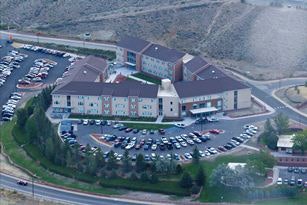Student housing at community colleges is somewhat rare — only 28% of community colleges in America have on-campus dormitory options for their students. But the last twenty years have seen a growing number of community colleges try to find creative ways to help their students who are housing or food insecure.
“Students have to decide if they’re going to eat and pay rent, or be able to go to college,” said Dr. Martha Parham, the senior vice president of public relations at the American Association of Community Colleges (AACC).
 Many community colleges are considering offering student housing.
Many community colleges are considering offering student housing.The need for those solutions was heightened by the COVID-19 pandemic, and “things like transportation, living expenses, housing, access to broadband have come to the forefront,” said Parham.
Many community college students are parents, said Dr. Karen A. Stout, president of Achieving the Dream. “Their first priority is their children. Taking care of those first priorities like housing, food, and child care, will open the bandwidth for students to engage, to be more productive, because of the environment they’re in.”
“A lot of colleges are thinking differently about community-based partnerships, working with homeless communities and providers, thinking very creatively about being a venue for affordable housing,” said Stout.
Parham said that it can be shocking to look at community college statistics, “when you start to understand the real issues our students are facing.” Of community colleges students, in general, 30% are first generation students, 15% are single parents and older, she added. “The vast majority (72%) are working, so they’re attending part time. They’re trying to take care of their families and deal with the issues that life brings with it while trying to get an education.”
Parham adds though there is no empirical evidence that dormitories make dealing with all these issues better, solutions for student housing directly confront the major issues of housing and food insecurity.
Amarillo College in Amarillo, Texas has come up with a unique partnership to provide housing options for their students. Three years ago, they partnered with the city of Amarillo itself to offer Housing and Urban Development (HUD) vouchers for their qualifying students.
“15% of our students are considered homeless,” said Cara Crowley, vice president of strategic initiatives at Amarillo College. “50% are housing or food insecure. We’re not a college that’s going to see these numbers and not figure out a solution.”
Their partnership with the city has correlated into 50 housing vouchers per year for their students.
“50 is not enough,” said Crowley, “But it’s the best we can do.” At the end of July, they will meet with the city again to discuss the partnership’s success and make the push for more HUD passes.
 Cara Crowley
Cara CrowleyCrowley knows that those HUD vouchers, even just 50 of them, have already made a difference. One of their student employees “was able to stay in school because of this. She would have had to drop out.”
“Something people don’t understand: so often students have to drop out — they don’t want to, but they have to — because they’re living on the edge of poverty,” said Crowley.
Amarillo is situated near the middle of the Texas panhandle, which has about 30,000 square miles of rural land. Getting broadband service to those remote locations is difficult and cost-prohibitive, so during the COVID-19 pandemic, Amarillo College “always kept one building open with safety protocols in place, because we knew our students had to have a place to come,” said Crowley.
While Amarillo College is unlikely, said Crowley, to consider building its own student housing due to the cost, the institution is “better served partnering with the community.”
In November of 2019, the state board that oversees Virginia’s Community College (VCC) system voted unanimously to allow the community colleges within their system to explore the potential of building dormitories to serve their populations. Jeff Kraus, the assistant vice chancellor for strategic communications for the VCC said that the board expressed an interest in exploring that idea in the wake of the COVID-19 pandemic.
In January 2021, Southwest Virginia Community College came to the board with an idea: their college foundation would pay for, construct, and operate student housing across the road from the college. While the idea itself is still just a concept at this point it signals movement.
 Dr. Karen A. Stout
Dr. Karen A. StoutVCC is about to embark on a six-year equity-centered mission called Opportunity 2027, where VCC institutions will work to directly address issues of access.
“The debate always hinges on access,” Kraus said. The question will be presented: “Would residence halls help with access, especially in terms of social equity?”
Stout thinks about the benefits that housing solutions can present.
“Some of the students I worked with would be studying without electricity and heat,” she said. “The instability that that causes — having a consistent, safe, well lit, well heated place to live and study with strong broadband is a basic need.”
Liann Herder can be reached at [email protected]



















